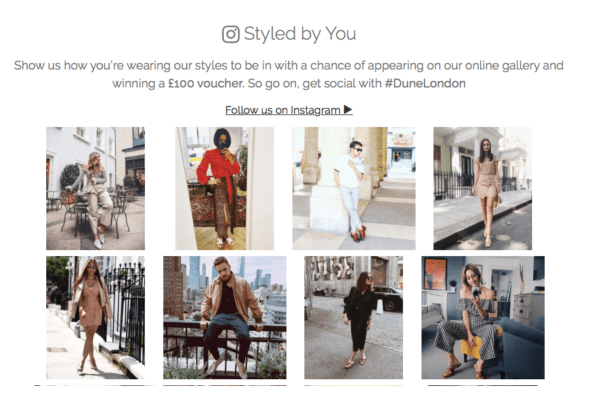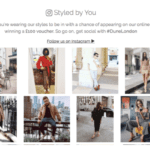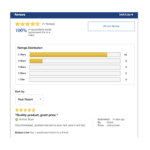Explaining to the customer just how products are relevant to them and will meet their needs helps them to buy with confidence. That’s key to merchandising in a digital world. Chloe Rigby collects 12 practical approaches that Top500 retailers are taking in this area.
1. Picture it!
Clear images help shoppers to understand what they’re getting. When they can zoom in and see an item from 360 degrees they understand whether it has all the features they’re looking for.
Research carried out by Opinium for Barclaycard suggested that images, along with good product details, videos and more, can help to reduce the rate of returns. That’s particularly important for clothing retailers, where communicating how things fit helps shoppers to be more confident about their purchases.
RetailX research shows that in 2018, retailers used a median of four product images on desktop websites and three on the mobile app. Almost half (48%) gave viewers a choice of image on the mobile app – but the remaining 52% did not.
2. Mind the gap
For digital shoppers there’s often a gap between what they see on screen and what they get when they order.
In the recent research mentioned above, Barclaycard suggested that shoppers are sending back almost half of the fashion items they buy online. Often that’s because they find the item doesn’t fit – or they buy multiple sizes in order to find the one that does.
Fashion retailers have tried a variety of approaches to help shoppers understand how that brand will fit them, from size guides to virtual wardrobes. Warehouse collects vital statistics to deliver a verdict on how a given product will fit, using Fit Match from Rakuten Fits Me, while Asos collects that information as well as the size that shoppers take in its Fit Assistant in order to deliver a verdict on how an item would fit, and what most ‘people like you’ bought – and didn’t return.
Furniture and make up retailers are among the 3% of IRUK Top500 retailers that use augmented reality to show shoppers how goods would look on them, or in their home. DFS enables shoppers to see how a sofa would look in their living space, FeelUnique lets users see what makeup would look like on them, while the Tiffany ring finder shows customers how a ring would look on their finger.
3. Use visual search to help customers find the right item…
Visual search gives shoppers another way to identify the item they want to buy. Matching an item to a photograph becomes easier using this functionality, available via the mobile apps of retailers including very.co.uk and, more recently, Asos. Asos, which has a range of more than 85,000 items, said at the time it launched visual search back in August 2017, that the functionality reflected its customers’ shopping behaviour.
At the time it said that 80% of Asos’ UK traffic came from a mobile device, along with almost 70% of UK orders. “We know this is where our customers are and it’s how they interact with us every day, so we are always looking for ways that are mobile native to make their experience even better,” said Andy Berks, Asos’ digital product director.
He added: “Inspiration can strike you anywhere and at any time, whether it’s a photo in a magazine, scrolling through an Instagram feed or even on a local street corner. Now, with just a couple of taps of their mobile device, Asos customers can capture that fleeting moment and instantly search our 85,000 product lines to find the item that’s inspired them – or similar – at just the right time.” The research finding that this isn’t yet a commonly found feature – at 2% of retailers – means adding this in can help retailers differentiate themselves.
4. …and think about how your target audience would use voice search
Voice assistants are growing their audience quickly and all the signs are that they’re set to be widely used within a few years. So far it seems that department stores, such as Amazon, and grocers – the technology is now in use by Ocado and Tesco – are relatively easily able to interpret commands for standard items and to use insights from customers’ shopping history to understand exactly which product they are likely to want. But as shoppers start to use voice commerce more widely in their lives, it’s likely they’ll start to expect to buy from other retailers as well.
5. Give advice that customers can rely on
Advice from a style assistant can help make the sale. When advice on what suits and doesn’t suit a customer and their shape helps them to look better, they’ll more likely to buy with confidence and come back to buy again.
Retailers including John Lewis and Debenhams are offering the service in store, building them into the customer’s experience. Online retailer MatchesFashion has a team of private shoppers that build one-to-one relationships with their customers. Now Amazon is adding artificial intelligence to the mix, harnessing the power of machine learning to offer style advice on the outfit you have on, using its new Echo Look, now available to customers in the US.
The device has a camera that can take an image or video and then upload it to its Style Check system. At launch, Linda Ranz, director of Echo product management at Amazon, said: “Alexa helps you nail your look every time – with Echo Look she can give advice on which of two outfits looks best, offer personalised recommendations on items that pair well with clothes you already own, create your personal lookbook, keep your closet organised, and much more.”
6. Make the most of user-generated content
Many customers are more than happy to let others know how purchases worked out for them. They post reviews, images and videos of the purchases that worked from them on retail websites as well as social media sites. Made.com has a community of satisfied buyers happy to share their images of how a piece of furniture looks in their home on Made Unboxed, while Dune London has brought content shared by customers on social media onto its own website enabling customers to shop the look.
Dune added customer and blogger content from Instagram to its product detail pages, using technology from Curalate, and found that sales rose by 82% after shoppers interacted with the content. An email campaign featuring Dune’s Your Style gallery received 55% more click throughs than previous emails that didn’t feature UGC. The gallery also drove a six-fold increase in revenue.
“Our customers respond very well to UGC – being able to see others wearing our products gives them the extra confidence to purchase,” said Mark Blenkinsop, digital marketing manager at Dune London. “This is the latest step in a wider strategy to leverage these images as well as our own beautiful lifestyle content across the web and make the products contained within photos and videos fully shoppable. Rather than asking customers to search for what they’ve seen, we’re taking them directly to it.”
7. Take the interruptions out of browsing…
Shoppers who are ‘just looking’ for an item from their mobile phone or tablet computer may move on faster when they need to click to view the next page. A quarter (25.1%) of IRUK Top500 retailers use infinite scrolling on their mobile websites, preventing interruptions to the browsing experience. This feature seems to work particularly well for fashion retailers, selling to customers who may be likely to be in a browse mode rather than aiming to finish a job quickly. RetailX research shows that it’s used by New Look, Next, Oasis and Simply Be, while in home-related categories, Wickes and Dunelm also use this feature.
8. …and make it easier for shoppers to get straight to the item they want
Navigational filters, whether on desktop or mobile, make it easier for shoppers to find the item they’re looking for and to browse items within a specific category. They’re particularly important for retailers with large ranges, whose customers like to search from mobile devices with small screens. Amazon stands out for its range of filters that customers can use to pinpoint the right item from a range of millions.
RetailX 2018 research analysed the use of different navigational filters and found that ‘by product’ was the most common, used by 91% of Top500 retailers – up by 32 percentage points from 59% a year earlier. That’s followed by price (81%) and by brand (46%).
Three-quarters of Top500 retailers also offer drop-down suggestions that pop up as a shopper types in the search box, another way to get directly to the exact item that’s required, while 27% of IRUK Top500 retailers that have a mobile app offer predictive search, and 57% of Top500 retailers have websites that when viewed from a mobile device offer autocomplete dropdown suggestions for search.
9. Give them the tools to find out more
Customers can find out more about a retailer’s products using a barcode scanner in their mobile app. The uses can be varied: John Lewis shoppers can scan a product they’ve previously bought and add it to their basket, Tesco shoppers can find out if the item meets their dietary requirements, while House of Fraser shoppers can scan in-store beacons and QR symbols in catalogues and find out more about products from clothing to homewares. In all, 25% of IRUK Top500 retailers with an iOS app have this feature.
10. Let browsers know what buyers thought
Sharing reviews, and star ratings, gives customers another way to understand whether the product is right for them. They can see what other customers thought about its different features – and give useful feedback on what didn’t work that can help retailers to rethink their products for the future. On its website, DIY retailer Wickes gives a useful summary of ratings, showing how many reviews an item has and how the star ratings were distributed.
RetailX research suggests that most leading UK retailers see the need too. In 2018, 62% of IRUK Top500 retailers enabled shoppers to leave their product ratings and 61% product reviews on their desktop ecommerce websites. There’s room to differentiate by offering reviews and ratings on mobile apps: just 15% Top500 retailers offered this, while 26% had written product reviews.
But it’s important that reviews show the full picture: the UK’s Competition and Markets Authority (CMA) has acted against at least one online retailer that did not share their unfavourable reviews. Nisha Arora, CMA senior director, says: “Shoppers worldwide are increasingly relying on online reviews and endorsements before they make a decision to buy a product or service. People need to know they can trust the information they find online, and make informed choices as a result.”
11. Make relevant recommendations
Sending reminders that are relevant to the consumer can play a large part in making a sale. When relevant reminders arrive at the right time and place, they’re still more relevant. More than half of IRUK Top50 retailers (52%) with a mobile app use push messaging, ensuring that messages about summer sales or local store events arrive at their destination fast. Post-GDPR, retailers must ensure that customers actively consent to receiving their messages: those that do sign up are likely to be more actively engaged.
12. Make checkout easier
Many retailers have gone to work over the last year to simplify their checkout, removing friction that could prove a barrier to buying. RetailX research found that in 2018, fewer Top500 retailers than last year now require customers to register before they buy. The figure has fallen to 36% in 2018 from 44% in 2018. In 2018 retailers asked shoppers to complete a median of two pages in order to complete their checkout. But leaders such as Amazon enable fast payment in one or two clicks.







